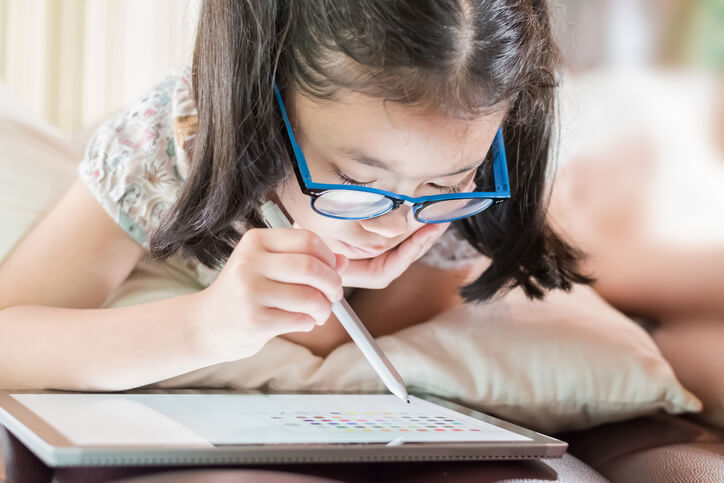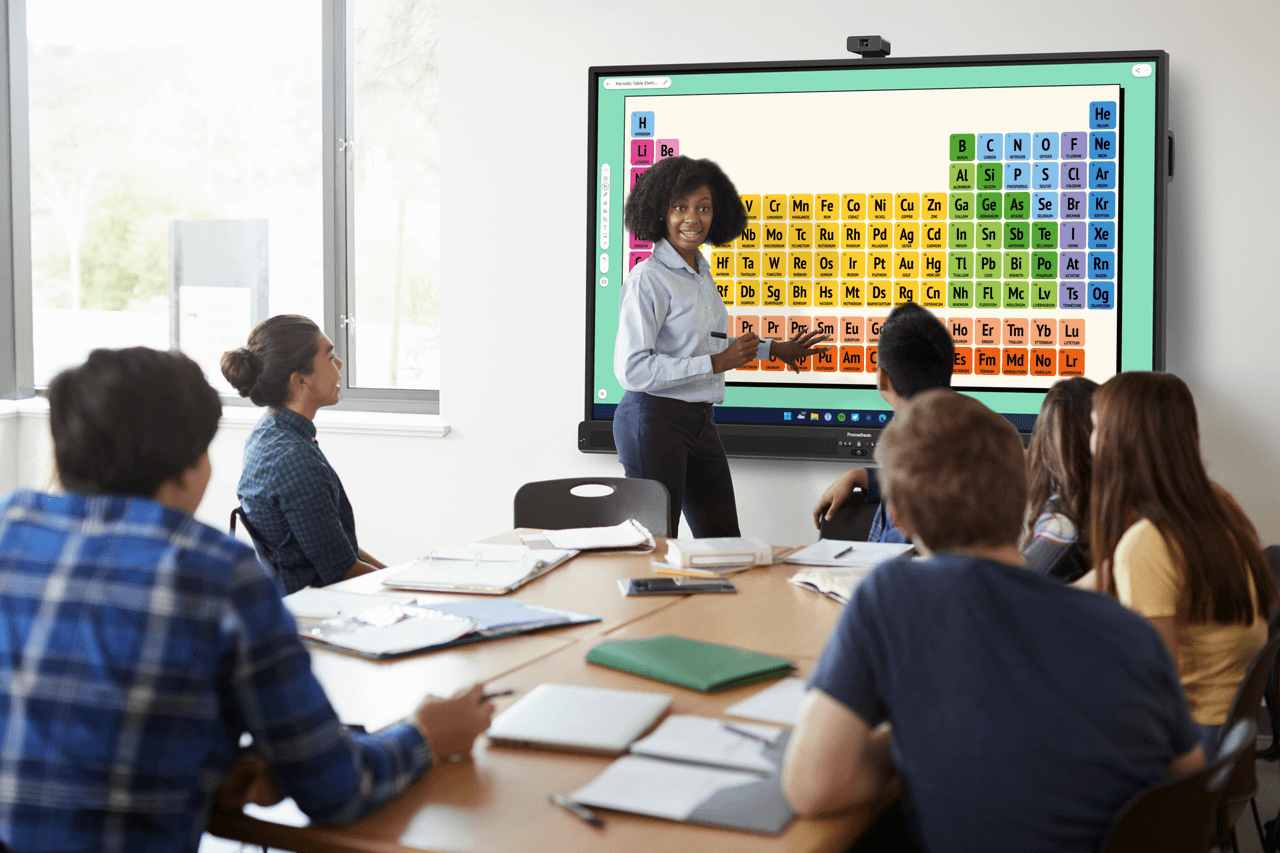Published on October 5th, 2022
What are the 4 types of learning styles and what do they mean for a modern classroom?
10 minute read

Take a second to reflect on your students – do some children always have a book in their hand? Are others constantly humming or singing? Do other students doodle while you’re speaking but pay attention when you draw on the board?
These are all examples of learning styles as demonstrated by Fleming & Mills in their four-part learning preferences model, commonly known as VARK: Visual, Auditory, Read/write, and Kinesthetic.
It’s important for teachers to both understand and accommodate these styles in the classroom, because once you know how these learning styles affect your students, you can use your interactive display more efficiently. Keep reading to learn more about the VARK model of learning styles.
V – Visual

Visual learners have a better grasp of information when it’s presented via maps, diagrams, flow charts, or hierarchies.
However, visual learners don’t just need pictures and charts; they need difficult concepts to be presented in completely different ways.
For example, words on a page might try to describe how many people prefer red kites, but a pie chart will make more sense to visual learners.
Visual learning in the modern classroom
ActivInspire, Promethean’s free teaching software, makes it easy to present information to visual learners. These tools are at your disposal if you need to share information in flipcharts or make images interactive.
Capture images and video with a swipe of your finger
Education technology should be so easy to use that it’s almost second nature. ActivInspire lets you screen-capture images and videos for closer inspection, which is particularly helpful in art and science lessons.
Capture images and videos with a swipe, then pull them onto the display so students can engage and interact with the lesson.
Closely examine 3D objects and models
When visual learners see images from different angles, they can commit the information to memory more easily.
With the XY Origin tool, you can change the rotation point of any object on a flipchart. This allows teachers and students to explore 3D objects and models in real-time.
A – Auditory

Aural or auditory learners prefer to hear information, whether they listen to someone else say it or they say it themselves.
The biggest misunderstanding with auditory learners is that they just need to hear information. Many people with this modality will remember concepts better if they speak them out loud to themselves or to a partner or group.
Auditory learning in the modern classroom
Supplementary audio podcasts
Offer auditory learners audiobooks or supplementary audio podcasts. Allow these students to hear the information repeatedly at their own pace.
At home, they can study by listening to audiobooks or podcasts and reciting the information they’re learning.
Class debates and discussions
Auditory learners also retain information more effectively when they speak. This is why organizing class discussions will increase participation among auditory learners.
As they participate in class debates, they activate the parts of their brain that transfer new concepts into familiar ones.
R – Reading and Writing

Students who learn best by reading and writing need to see the words on the screen or in a book while listening.
This modality includes learning by reading and by writing the information down. Interactive displays that allow students to write on the panel will engage this part of their brain.
Reading and writing in the modern classroom
Follow-along reading time
Reading and writing learners need words in front of them during reading time. That can be a physical book or words on the screen while the teacher reads it out loud.
As long as they can follow along, these learners will be able to participate.
Write stories or poetry that corresponds with the lesson
Think of new ways to help these learners recreate what they’re learning. Encourage them to write stories or poetry that match your teaching.
As they use words in this new way, they’re transforming the concepts into something they can explain.
K – Kinesthetic

This is also commonly called “hands-on learning.” It describes anyone who learns through experience and practice. The key to this learning style is to provide concrete examples they can see, manipulate, and actually do.
Kinesthetic learning in the modern classroom
Simulations with 3D graphics
Kinesthetic learners don’t have to hold the manipulatives in their hands, necessarily; they can work virtually as well. They will enjoy moving 3D objects around on the screen, zooming in and out, and looking at them from all points of view.
You can also simulate experiences for them. For example, instead of physical coins, allow students to move images of coins around on the screen as they count the money.
Conduct experiments (either online or in-Person) and discuss
Edtech also allows kinesthetic learners to conduct experiments and discuss their findings with the class. You can either set up in-person experiments or use the ActivInspire software to create online experiments.
As long as the students are actively involved in the experiments, they take control of their learning.
History of the theory
The idea behind learning styles is a theory that’s constantly evolving and changing as we gain more information about how students retain information. The history of the theory of VARK modalities is fascinating and shows how much educators care about their students.
1907
Dr. Maria Montessori was one of the first educators to pioneer the idea of different learning styles. Dr. Montessori was an Italian educator and scientist who established a childcare center in a poor, inner-city district of Rome. She created an educational environment for children who many thought were unable to learn.
She did this by focusing on how children learn at each stage of their development, teaching them right where they were.
1956
In 1956, educational psychologist Benjamin Bloom published his taxonomy. He worked with his colleagues to create a system that classified the levels of cognitive function.
This taxonomy began to provide structure for educators. From the lowest order of thinking skills (general knowledge) to the highest order (evaluation), it helped educators create lessons that build on each other appropriately.
1962
In 1962, Katharine Cook Briggs and her daughter, Isabel Briggs Myers, researched personality types. Together, they published their research and created the Myers-Briggs Type Indicator (MBTI).
The MBTI sought to describe how people perceive their world and judge it. Everyone has a unique personality that falls on a spectrum within any number of combinations of the 16 personalities that Katharine Cook Briggs and Isabel Briggs Meyers established.
1976
In the 1970s, Kenneth and Rita Dunn worked with the New York State Department of Education to help students improve learning outcomes. Their research discovered environmental, emotional, sociological, and psychological factors that affect learning.
In this case, learning style describes the time of day, mood, emotions, and other stimuli that affect children when they’re trying to learn.
1984
In 1984, David Kolb emphasized that learning happens naturally. He created a Theory of Experiential Learning, which states the importance of students experiencing things in order to learn them.
1992
Educational researchers Neil Fleming and Colleen Mills published the VARK theory in 1992. It gave us the words educators use to this day to describe how students learn best.
Some learn through hearing, others through charts and graphs, others by doing experiments, and others by reading and writing.
Promethean products support all learning styles
From on-screen image capture to 3D simulation, Promethean products are designed to reach all students, no matter their learning style. We listen to teachers’ greatest challenges in the classroom, and we create and adapt our products accordingly.
Contact us to request a live demo so you can see the ActivPanel in action. You’ll discover how much easier ActivInspire and our interactive displays for schools can make your teaching.




